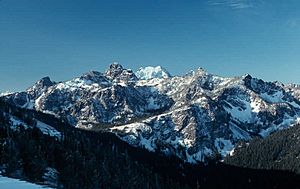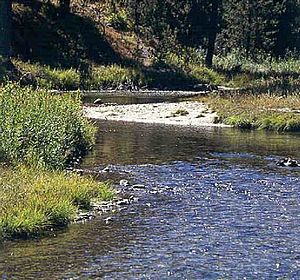Environment of Idaho facts for kids
Idaho has an amazing natural environment with many different kinds of plants and animals. The northern part of the state is mostly covered by thick forests. These include grand fir and Douglas fir forests, along with forests of cedar, hemlock, and pine trees.
In the southern part of Idaho, you'll mostly find wide-open sagebrush steppe. This is a dry area with low-growing plants like sagebrush. You can also find smaller areas of desert and saltbush-greasewood shrublands.
Many parts of Idaho are still wild and untouched. Some areas are so natural that they are among the largest places in the United States without any paved roads.
Idaho is also home to important fish like salmon and steelhead.
Fire's Role in Idaho's Nature
Fire is a natural and important part of many of Idaho's wild places. This includes the sagebrush steppe, woodlands with western juniper trees, and forests of ponderosa and lodgepole pine.
For many years, people tried to stop all wildfires. This is called fire suppression. This, along with other ways we use the land, has changed how forests look and what plants grow there.
In the sagebrush steppe, there have been more fires in the last 50 years. This has led to new grasses like cheatgrass and medusahead growing where they didn't before.
In western juniper woodlands, grazing animals and trying to stop fires for 50 years have allowed juniper trees to spread too much.
Historically, small, frequent fires would clear out the undergrowth in ponderosa pine forests. This made them look like parks with widely spaced trees. But after 60 years of stopping fires, many of these forests now have too many trees. This makes them more likely to suffer from insect outbreaks, diseases, and very large, destructive fires.
Whitebark pine trees in high-up forests are also changing a lot. In northern Idaho, these forests have shrunk by 50% to 100%. This is partly because of fire suppression and a disease called white pine blister rust. This disease is caused by a fungus that is not from Idaho, and it's very hard to control. Less than 1 in 10,000 trees can fight it off.
Losing these whitebark pine forests could be very bad for grizzly bears. Even a small amount of warming and drying could reduce their habitat by up to 90%. Whitebark pine nuts and army cutworm moth caterpillars are super important foods for grizzly bears.
Amazing Public Parks
Yellowstone National Park is the most famous protected area in this region. It's a special place where grizzly bears have safe homes. It also has wide-open rangelands for animals like buffalo, elk, and moose.
Millions of people visit Yellowstone every year to see its amazing hot springs and geysers, which are like natural fountains of hot water and steam.
How Climate Change Affects Idaho
Over the last 100 years, the average temperature near Boise, Idaho, has gone up by almost 1°F. The amount of rain and snow (precipitation) has also changed. Some parts of Idaho have gotten nearly 20% more precipitation, while others have gotten more than 10% less. We don't know if these changes will keep happening in the future.
Scientists think Idaho's climate might change even more in the next 100 years. For example, experts from the Intergovernmental Panel on Climate Change use special computer models. One model suggests that by the year 2100, temperatures in Idaho could go up by 5°F in winter and summer. They might also increase by 4°F in spring and fall.
This model also suggests that summer precipitation might not change much. But it could increase by 10% in spring and fall, and by 20% in winter. Other models might show different results, especially for precipitation.
It's likely that on very wet or snowy days in winter, there will be even more precipitation. Also, the number of extremely hot days in summer would increase because of the overall warming trend. We are not sure how strong storms might become, but it's possible that winter storms could happen more often and be more intense.




